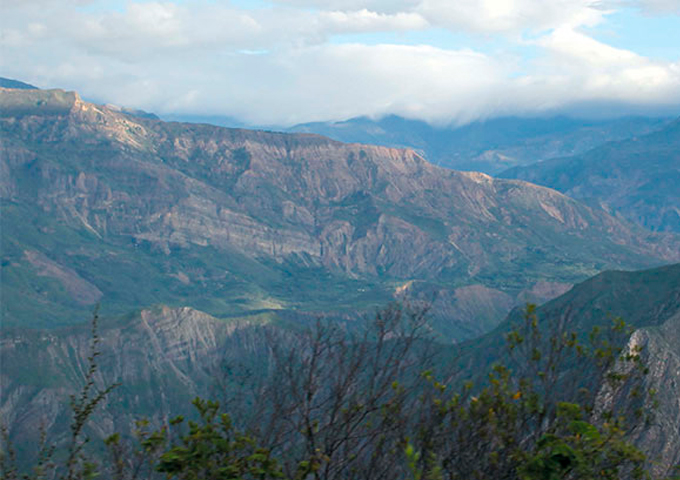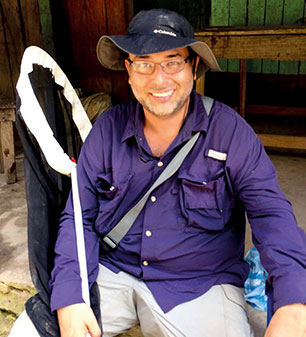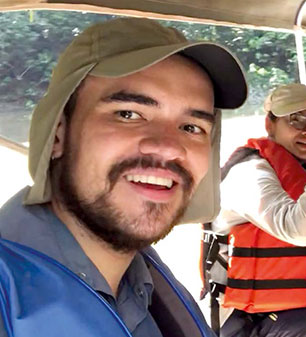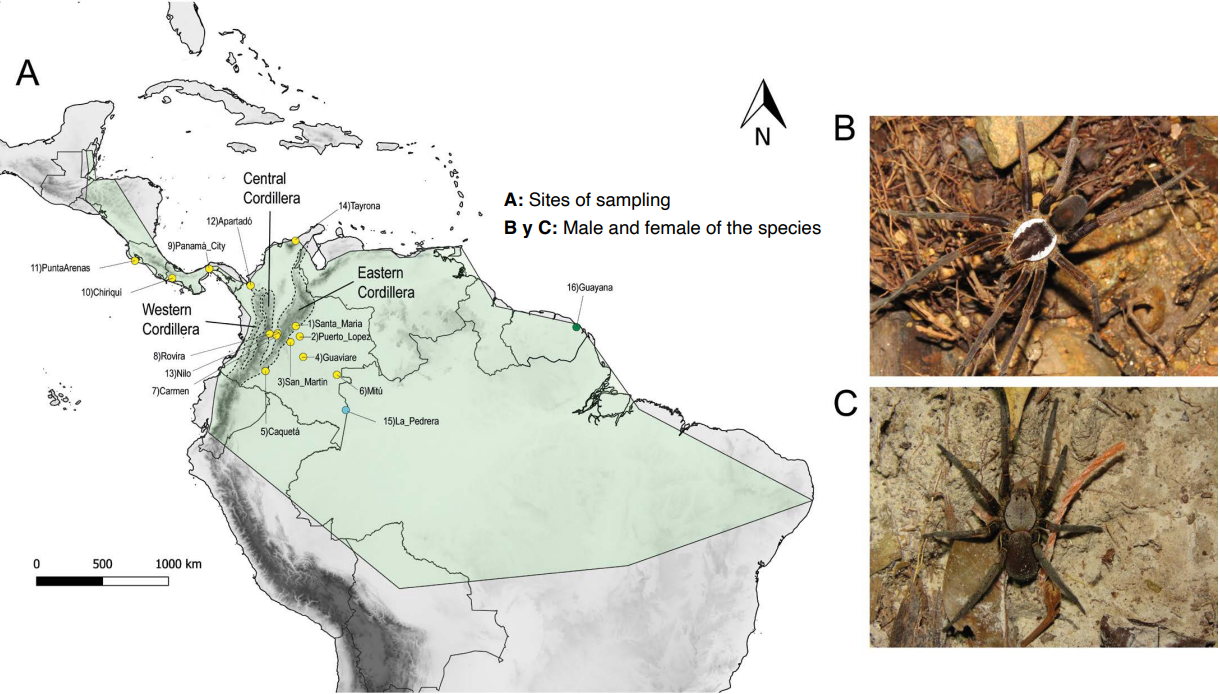The story told by the genes: The uplifting of the eastern cordillera diversified a species of spiders
By: Ximena Serrano Gil
Photos:
Environment

By: Ximena Serrano Gil
Photos:
The story tells that, from the depths of the Earth, more than 25 million years ago, enormous rock formations began to emerge, giving rise to the Eastern Colombian Andes Cordillera. This event triggered the formation of new species because its uplifting caused the division of plant and animal populations that remained on both sides of this mountain range.
Following the outcome of this story, and to in - vestigate the diversification of populations within species as a consequence of geographic isolation, researchers from the Faculty of Natural Sciences of the Universidad del Rosario, Fabián Camilo Salgado Roa andCamilo Andrés Salazar Clavijo, studied the variation in the DNA of different families of the fishing spider Ancylometes bogotensis (Araneae: Ctenidae) along their distribution in the mountain range and de - termined whether the mountain contributes to their genetic differentiation.
The protagonist, Ancylometes bogotensis, is a giant fishing spider that reaches a size of up to 26 centimeters and is found from Bolivia to Honduras from 0 to 1,500 meters a.s.l. and lives near water bodies. It does not make spider webs and hunts at night; its preys include insects, frogs, tadpoles, fish, and even freshwater crabs, and it has been reported that this spider has the ability to remain underwater for 20 minutes.
Ironically, the name of the species bogotensis does not mean that it comes from Bogota. The origin of its name is due to the fact that most of the specimens gathered, which were sent to European museums, originated in Bogota. This species was introduced in 1867, and the holotype, the first individual that was collected and used for identification, is in Germany, and the syntype (copy of the first one) is in Switzerland, which is another example of scientific colonialism.
Thrilled to study this family of spiders, Fabián Salgado, a biologist by profession and arachnologist by nature, says, “We wanted to determine whether the Andes Mountains are an absolute barrier, i.e., if Ancylometes bogotensis, owing to its traits, is not able to cross them and prevent their populations from interconnecting”.
Moreover, a researcher in evolutive genetics, Camilo Salazar, states that they obtained molecular and climatic evidence about the importance of the orogeny (formation of the mountains) of the Andes with this research, either separating lineages or facilitating their spread.
Therefore, following the track of this evolutionary history, the scientists created a kinship relationship between the populations of the species, i.e., a combination of phylogenies, population genetic analysis, and species distribution models.
The results detected two lineages that are separated by the Eastern Cordillera of the Colombian Andes that share the same weather niche, which is defined as the weather variables that can affect or favor an organism to inhabit an area. Furthermore, they investigated the extent to which the northern Andes contributed to the diversity of Ancylometes bogotensis.
In this regard, Salazar describes three different approaches to diversification processes:
1. The mountain divided what already existed, and over time, what is on one side no longer looks like what is on the other side..
2. The mountain emerged and created several thermal floors. These elevation changes are associated with the changes in vegetation and a number of weather phenomena that, combined with other biotic features, generate new ecological niches (interactions with the environment and other organisms), offering an opportunity for some organisms to adapt, colonize these spaces, and develop themselves as another entity different from the original population.
3. Organisms successfully spread across the mountain, colonizing populations on the opposite side.

“By understanding the natural history of organisms, we can understand how they differ as time passes, and therefore, we will understand the past.” Camilo Salazar, a professor at the Faculty of Natural Sciences at Universidad del Rosario.
Furthermore, the researchers explain that genes move constantly, so tracking them enables us to determine how much the species have traveled. This way, during many adventures, they traveled through 16 regions, from the forgotten Colombia in the Amazon region bordering Brazil, to Costa Rica, through Panama, to collect a total of 63 individuals from both sides of the mountain. The samples were analyzed at a laboratory to assess whether there was an exchange of genes across the mountain range.
Although many studies have focused on the importance of the Andes and their influence on biological diversity, especially in vertebrates such as birds or mammals, only a few studies have been conducted on invertebrates such as insects or spiders. For this reason, the research developed by Salgado and Salazar seeks to establish the generality or differences in the patterns of differentiation that may arise from the comparison of organisms with different biology and spreading capacity. These new findings will help fill the gap in the existing knowledge on arachnids, particularly in Colombia.
As a result of the analyses and findings obtained by the research group, Salgado, who is initiating his doctorate at the University of Melbourne (Australia), says, “The most important thing is that we succeeded in emonstrating with genetic and weather evidence that the Andes are an absolute barrier that completely prevents the populations of these spiders from communicating, and it seems that the Eastern Cordillera could have been the only one that contributed to their diversification.
We even propose that they may be different species, at least at the genetic level, where we found a very clear differentiation, but to arrive at the conclusion that they are two different species, we have to include morphological and behavioral evidence.
When did this happen? Determining the exact date and event of this separation is difficult because the times that are calculated with the molecular markers do not always coincide with the times or geological life of the mountains, which are usually older than what those markers report. “In our study, the estimated time of the divergence between the two subpopulations of A. bogotensis was approximately 3.85 million years. This is the maximum backward range that the genes allow us to see,” explains scientist Salazar.
Although the uplifting of the mountains has been extensively studied, there is a controversy about the dates because the Andes are not a single block but a set of uneven heights: “For example, a peak like Bogota may have a different age than Bucaramanga; therefore, there is no agreement on when the Eastern Cordillera appeared, which is the most studied area. This prevents us from concluding things with certainty,” states Salgado.
In this regard, the researcher adds, “According to the literature, the date of the last uplifting was 6 to 3 million
years ago, and as our separation occurred within that range, the conclusion was that the spider was already distributed throughout South America, the mountain appeared and split the groups in two (the distribution was changed).
However, a new trend says that, in fact, the Eastern Cordillera was already sufficiently uplifted 25 to 30 million years ago. As this date is much earlier than the one we described, the scenario would change, and this is more consistent with a scenario where the spider was on one side of the mountain, and by some kind of depression, the spider crossed it, locating a population on the other side. That is to say, it was differentiated by dispersion.
According to the analyses, the crossing of the mountain (dispersion) by A. bogotensis may be restricted by its low adaptability to the habitats and weather typical of the highlands, which may prevent its survival. Furthermore, spiders with specific habitats such as water bodies usually do not disperse. Considering the controversy over the dating of the cordillera, Salazar states, “The story that is told from genetic changes is the story of the time frame where two populations find a common ancestor. This information must be complemented/contrasted with evidence from other sources that allows us to estimate dates, such as those
that can be extracted from geological studies.”
It is important to note that this study brings together all the stages of the formative process of the scientific work and involves researchers from all academic levels of Universidad del Rosario. The work was a part of the undergraduate thesis of Andrés Gámez, a student of the Biology Program at the Faculty of Natural Sciences, who in his training process learned the methods of data collection. The findings and contributions of this study will make it easier for any scientist with the DNA samples of A. bogotensis to classify them according to which part of the mountain they come from.

Biologist Fabián Salgado, a professor at the Faculty of Natural Sciences, explains: “The most important thing is that we succeeded in demonstrating with genetic and weather evidence that the Andes are an absolute barrier that completely prevents spider populations from interbreeding".
Sites of the collection of individuals, throughout Colombia, Panama, and Costa Rica.
